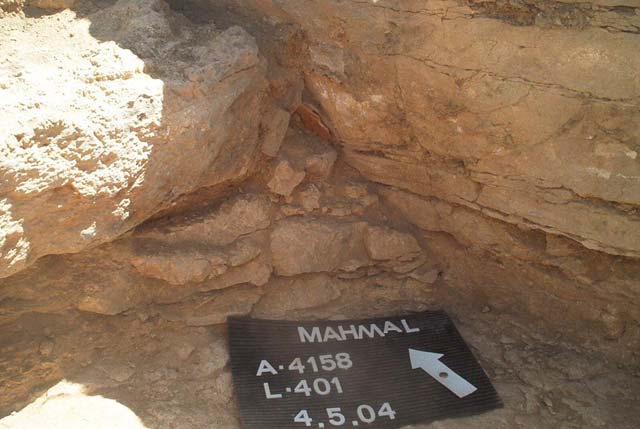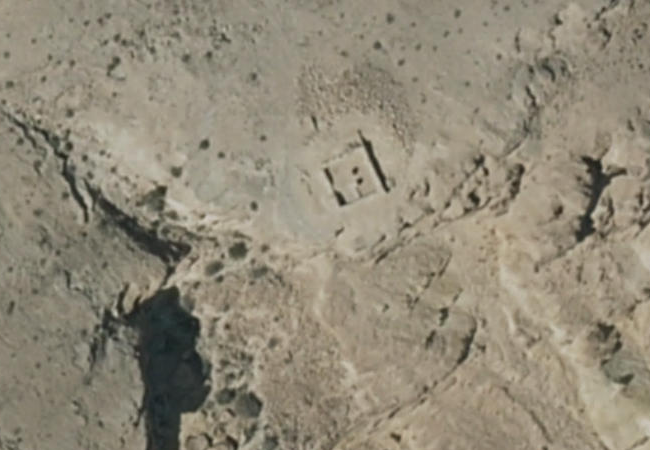Mezad Mahmal
| Transliterated Name | Source | Name |
|---|---|---|
| Mezad Mahmal | Hebrew | |
| Mezad Ma'ale Mahmal | Hebrew | |
Description and History
- from Erickson-Gini (2011)
Description and Excavations
The site at the top ofMa'ale Mal).mal (map reference 1431.9111), on the edge of the northern cliff of Makhtesh Ramon, was first surveyed in 1937 by G. E. Kirk, who was also the first to examine Ma'ale Mal).mal. In 1960, it was surveyed by B. Rothenberg and M. Gichon. In 1965, a trial excavation was carried out here by Z. Meshel, Y. Tsafrir, and R. Cohen, in the course of a survey of the road from Sha 'ar Ramon to 'Avdat (Oboda). The excavation was completed by Cohen in 1982. The almost square fort (7 by 6.5 m) was divided into two parallel halls (each c. 5.6 by 2.6m); each was preserved to a height of some 1.8 m. A staircase in the southern part of the western hall led to the upper story. The one-meter-wide entrance to the fort was pierced in the center of the western wall. Parts of the arch that originally spanned the entrance were found in the debris. Two floors were identified, with a fill 0.3 m deep in between. On the earlier floor a few isolated sherds, probably dating to the first century CE, were found. The finds on the upper floor were typical of the third to fourth centuries CE: an oil lamp, a small bowl, a late Nabatean painted bowl, a flask, and two coins from the third century issued under the emperor Gallienus (260-268).
Maps, Aerial Views, Plans, and Photos
Maps
- Fig. 1 Location Map
from Erickson-Gini (2011)

 Figure 1
Figure 1
Location Map
Erickson-Gini (2011)
Aerial Views
Plans
- Fig. 3 Plan of Mezad Mahmal
from Erickson-Gini (2011)

 Figure 3
Figure 3
Plan
Erickson-Gini (2011)
Photos
- Mezad Mahmal (long shot)
from Rudolf Cohen in Stern et. al. (1993 v.3)

 Mezad Ma'ale Mahmal: general view
Mezad Ma'ale Mahmal: general view
Stern et. al. (1993 v.3) - Mezad Mahmal (close up)
from Rudolf Cohen in Stern et. al. (1993 v.3)

 Mezad Ma'ale Mahmal.
Mezad Ma'ale Mahmal.
Stern et. al. (1993 v.3) - Fig. 2 Mezad Mahmal (close up)
from Erickson-Gini (2011)

 Figure 2
Figure 2
Late Roman fort, looking northeast
Erickson-Gini (2011) - Fig. 6 Tabun F-1
from Erickson-Gini (2011)

 Figure 6
Figure 6
Tabun F-1, looking west
Erickson-Gini (2011) - Fig. 7 - Jar in collapse
from Erickson-Gini (2011)

 Figure 7
Figure 7
Jar in collapse in the corner of L402, looking northwest.
Erickson-Gini (2011) - Fig. 8 - Collapse of Wall 1
from Erickson-Gini (2011)

 Figure 8
Figure 8
Collapse of Wall 1 in the courtyard, looking west.
Erickson-Gini (2011)
General Chronology
- from Erickson-Gini (2011)
... earlier remains appear to belong to an Early Roman Nabataean caravan station destroyed in the early second century CE by an earthquake.
Caravan Station Earthquake - Early 2nd century CE
Plans and Photos
- Plan of Mezad Mahmal
from Erickson-Gini (2011)

 Figure 3
Figure 3
Plan
Erickson-Gini (2011) - Fig. 7 - Jar in collapse
from Erickson-Gini (2011)

 Figure 7
Figure 7
Jar in collapse in the corner of L402, looking northwest.
Erickson-Gini (2011) - Fig. 8 - Collapse of Wall 1
from Erickson-Gini (2011)

 Figure 8
Figure 8
Collapse of Wall 1 in the courtyard, looking west.
Erickson-Gini (2011)
Discussion
Notes by JW
Erickson-Gini (2011) excavated 6 meters west of the fort and found remains
which appear to belong to an Early Roman Nabataean caravan station destroyed in the early second century CE by an earthquake.
They described what they
found as follows:
Pottery found in the excavation of the building shows that it was founded in the mid-first century CE and continued to be used until sometime in the early second century CE, when it was evidently destroyed in an earthquake (Fig. 7). Wall 1 appears to have collapsed northward (Fig. 8) and the remains of a cooking pot (Fig. 10:8) in L601, next to the tabun (F-1), had broke and was partially spread eastward next to the interior of W1. Tabun F-1 contained small rocks and a number of potsherds, including an early type of a Gaza wine jar (Fig. 10:11) that is dated to the first–third centuries CE. Other diagnostic potsherds included parts of Nabataean painted ware bowls (Fig. 9:1–8), an Eastern Sigilatta ware bowl (Fig. 10:1), undecorated cups and bowls (Fig. 10:2–5, 7), Nabataean rouletted ware (Fig. 10:6), Nabataean cooking pot (Fig. 10:9), Roman carinated cooking pot (Fig. 10:10), jars (Fig. 10:12, 13), Nabataean strainer jugs (Fig. 10:14, 15) and a fragment of a Roman lamp with a decorated discus (Fig. 10:16).
Visual investigation of the area north of the early structure shows traces of possible wall lines and other rooms. However, no plan of this structure can be determined without carrying out further excavations. It may be assumed, on the basis of the 2004 excavation, that rooms were situated around an open courtyard. The structure was badly damaged by an earthquake and appears to have been stripped of masonry stones nearly to its foundation.
... In addition to excavations in the early building, the exterior sides of the Roman fort along the eastern, northern and part of the western side, were excavated to facilitate restoration work on the structure (L101/L102, L103, L201 and L801). A deep probe along the northeastern corner of the structure (L103) was excavated down to bedrock. In the foundation trench near bedrock a diagnostic fragment of a Late Roman-Nabataean debased painted ware bowl (Fig. 9:9) was found. The structure showed signs of earthquake damage along its northern wall (L201) and the center of this wall had collapsed northward. A section of collapse at this point of the wall was preserved and left unexcavated.
The current excavation confirmed the discovery that the Mezad Mahmal fort is a Roman and not a Nabataean fort, as has generally been assumed. The fort was constructed in the later half of the second century CE in the Late Roman period. It appears to belong to a Roman military initiative of constructing tower forts in the Severan period elsewhere along the Petra–Gaza road, such as the fort of Horbat Qazra and Mezad Neqarot. Other forts of this type and period are known at Horbat Haluqim (‘Atiqot 11 [ES]:34–50) and Horbat Dafit (ESI 3:16–17). The primary discovery in this season was the remains of the Nabataean caravan station of the first century CE, situated at the head of the pass. This structure, which apparently contained a number of rooms located around a central courtyard, was destroyed in a seismic event in the early second century CE and subsequently, was probably abandoned.
Caravan Station Earthquake - Early 2nd century CE
| Effect(s) | Location | Image(s) | Description |
|---|---|---|---|
| Collapsed Walls |

 Figure 3
Figure 3Plan Erickson-Gini (2011) |

 Figure 8
Figure 8Collapse of Wall 1 in the courtyard, looking west. Erickson-Gini (2011) |
|
| Broken Pottery | L601
 Figure 3
Figure 3Plan Erickson-Gini (2011) |

 Figure 6
Figure 6Tabun F-1, looking west Erickson-Gini (2011) |
|
| Broken Pottery | L402
 Figure 3
Figure 3Plan Erickson-Gini (2011) |

 Figure 7
Figure 7Jar in collapse in the corner of L402, looking northwest. Erickson-Gini (2011) |
|
Caravan Station Earthquake - Early 2nd century CE
- Modified by JW from Fig. 3 of Erickson-Gini (2011)
Caravan Station Earthquake - Early 2nd century CE
-
Earthquake Archeological Effects chart
of Rodríguez-Pascua et al (2013: 221-224)

 Earthquake Archeological Effects (EAE)
Earthquake Archeological Effects (EAE)
Rodríguez-Pascua et al (2013: 221-224)
| Effect(s) | Location | Image(s) | Description | Intensity |
|---|---|---|---|---|
| Collapsed Walls |

 Figure 3
Figure 3Plan Erickson-Gini (2011) |

 Figure 8
Figure 8Collapse of Wall 1 in the courtyard, looking west. Erickson-Gini (2011) |
|
VIII+ |
| Broken Pottery | L601
 Figure 3
Figure 3Plan Erickson-Gini (2011) |

 Figure 6
Figure 6Tabun F-1, looking west Erickson-Gini (2011) |
|
VII+ |
| Broken Pottery | L402
 Figure 3
Figure 3Plan Erickson-Gini (2011) |

 Figure 7
Figure 7Jar in collapse in the corner of L402, looking northwest. Erickson-Gini (2011) |
|
VII+ |
References
Articles and Books
Bibliography from Stern et. al. (1993 v.3)
G. E. Kirk, PEQ 70 (1938), 232
Z. Meshel andY. Tsafrir, ibid. 106 (1974), 103-
118
107 (1975), 3-21
R. Cohen, ESI 2 (1983), 69-70
id., IEJ 34 (1984), 203.


